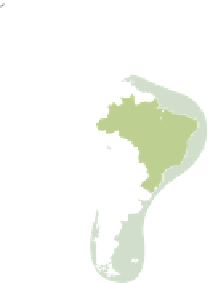Agriculture Reference
In-Depth Information
Origins
Horticulture and agriculture have a very long history.
There is evidence to suggest that areas now known
as Iraq were growing forms of flax, lentil and wheat
by 7000
BC
. It also appears that Chinese farmers
were cultivating rice by 6000
BC
and that Papua New
Guineans had root crops such as yams as early as
5000
BC
. Central American cultures are claimed to
have had
Phaseolus
beans, marrows, chilli peppers
and maize by 4000
BC
. South American and Egyptian
cultures had ornamental gardens as early as 1500
BC
.
India, Persia and Greece, among many others, later
developed ornamental horticulture and landscape
gardening .The fabled 'Hanging Gardens of Babylon',
listed as one of the 'wonders of the world', were
constructed around 600
BC
.
Influences in Europe came first with gardens
established by the Romans across their empire up
until about
AD
300. At about the same time, China
(and three centuries later, Japan) was developing its
own quite different styles of gardening on the other
side of the world. The 'Silk Road' from central China
to the eastern Mediterranean was also developing at
about this time and was one of the ways that plant
species were distributed across the continents.
Rosa
species from China, for example, were seen in Persian
gardens over two thousand years ago.
Much later, in southern Europe, the Spanish (fourteen
and sixteenth centuries
AD
), French (thirteenth and
eighteenth centuries
AD
) and Italians (fifteenth and
sixteenth centuries
AD
) developed a wide range of
gardening skills. Northwest Europe, including Britain
and Ireland, gained a keen interest in horticulture in
fifteenth century
AD
and this passion has grown since
then to equal any other part of the world.
Plants have been obtained from other areas of the
world by many cultures as awareness of suitably
decorative or edible species became known. At the
present time, an estimated 8,000 species of plant are
grown worldwide.
Centres of origin
Worldwide, distinct '
centres of origin
' can be
considered as important sources of crop and
ornamental species (Figure 2.2). Each of these centres
can be studied in terms of its plant
diversity
(the
number of
wild species
of a particular genus found
within the area (see also p. 34). Information of this
type is taken to indicate whether the area is a
focal
Caucasion-
Western
Asiatic
Macaronesian
North American
Mediterranean
European
Central
Asian
Eastern
Asian
Mesoamerican
Tropical
Asian
Australasian
African
South
American
Figure 2.2
The main centres of origin of plants





















































































































































































































































































































































































